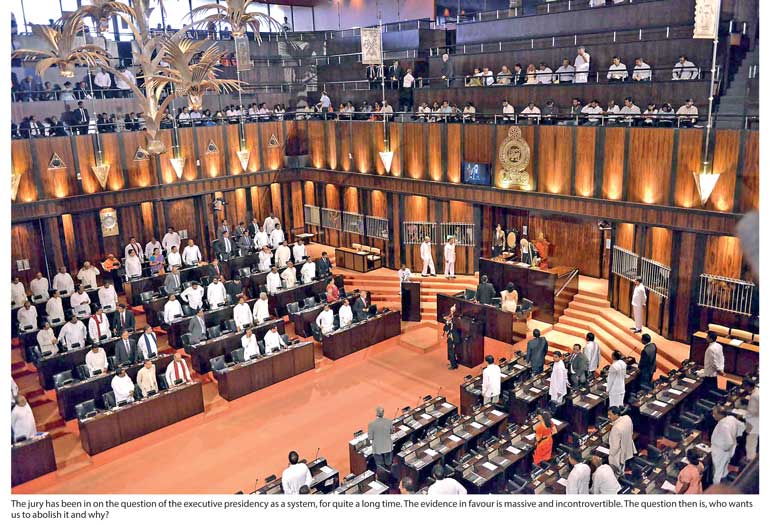Wednesday Mar 19, 2025
Wednesday Mar 19, 2025
Friday, 28 April 2017 00:00 - - {{hitsCtrl.values.hits}}
 Right of reply to Shyamon Jayasinghe
Right of reply to Shyamon Jayasinghe
In public as in private life, it is important to know when someone is attempting to scam you. The question then is “what’s his game?” or, as the famous line in British journalism goes “why is this b*****d lying to me?”
The jury has been in on the question of the executive presidency as a system, for quite a long time. The evidence in favour is massive and incontrovertible. The question then is, who wants us to abolish it and why?
The two most successful countries in the world are the USA and China, so much so that some refer to them as “G-2’, which means group of 2, and is a funny riff on the G-7. Both countries have executive presidential systems.
The most powerful and significant countries in the world are the Five Permanent members of the UN Security Council. Of the five, four have executive presidential systems: US, China, Russia, and France. Only Britain does not.
The fastest-growing zone of the world economically is East Asia. Most, though not all countries, in that region, have executive presidential systems: China (including Taiwan), Vietnam, South Korea, Indonesia and the Philippines.
The continent of the Americas, both North and South, is enveloped by executive presidencies from the USA through Cuba to the rest of Latin America. The sole exception is Canada.
Nelson Mandela chose the presidential system for South Africa.
So, on a world scale, it is obvious that most countries, and certainly the most important ones, have opted for the executive  presidential system whatever the respective ideologies of those societies and governments. Whatever the ideological contrasts and swings between and within societies, these countries have opted for the executive presidency.
presidential system whatever the respective ideologies of those societies and governments. Whatever the ideological contrasts and swings between and within societies, these countries have opted for the executive presidency.
Furthermore, no country which opted for an executive presidency has opted to reverse that choice and go for a parliamentary system. If at all – as in Turkey – countries opt to move to an executive presidency, and some even to remove term limits – Nicaragua, Venezuela.
All of this attests to the superiority of the executive presidency as system. If the criticism is of the working of the executive presidency in Sri Lanka, then that is quite obviously not evidence of the need to abolish the system. It is evidence of the need for reform, through amendments, of the system and within the system. Indeed that has been attempted by the 19th Amendment, which should be given a chance to work for at least a decade, preferably with different governments.
Let us then examine the evidence with respect to Sri Lanka. When we had a parliamentary system we had low economic growth, Sinhala only in 1956, the first race riots of 1958, the assassination of a Prime Minister, a coup attempt in 1962, a violent insurrection in 1971, the conversion of an ethno regional party to separatism in 1976, the founding of the Tiger movement in 1976 and the commencement of a Thirty Years War in the 1970s.
With the executive presidency we had high growth, maintaining approximately 5% even in wartime. We absorbed a foreign intervention and reversed it, won civil wars in South and North, defeated the world’s most powerful terrorist army, regained our territorial integrity, national sovereignty and territorial unity (borders), retained our multiparty democratic system and had successive elected governments, and had a postwar economic recovery which gave us the highest growth rate in Asia outside of China. By contrast, even the USA, the world sole superpower, has been unable to militarily defeat terrorism in any one of its ongoing wars. The Greater Middle East is a junkyard of wrecked states and societies. Sri Lanka by contrast is not a failed state, it is a successful one, which has passed many tests, each of which other states have failed.
The executive presidential system has been an important factor in our success. It has proven its superiority is ensuring relatively high economic growth and in the crucial matter of decision making in “extreme situations” – of a sort that most societies are faced with in today’s world due to terrorism and economic crisis, and this island would never be free from anyway, given our attractive geopolitical and geostrategic location and attendant vulnerabilities.
As for the nexus between instability, low economic growth and the parliamentary model on the one hand, and stability, high economic growth and the executive presidency on the other, the case was made in 1966 by J.R. Jayewardene and proved by the evidence (listed above) of subsequent decades. J.R. Jayewardene’s thinking was heavily influenced not only by the American model but more so by that of General Charles de Gaulle who introduced the system to France in 1958 as a bulwark against the kind of internal instability and external vulnerability that had made that great country a victim. This is why emeritus profess A.J. Wilson as correct when he defined the Jayewardene constitution of 1978 as ushering in “The Gaullist system in Asia”. This system has served us well, and France certainly does not want to dispose of it, as we see in the latest elections.
Who then wants to dispose of the executive presidency in Sri Lanka and to what end, with what probable result?
It is Mr. Ranil Wickremesinghe who has tried several times to be elected President but has failed and knows his best shot is at a Prime Ministership with executive power; Madam Chandrika Bandaranaike Kumaratunga who knows she cannot be reelected President but wants a system where she can play Sonia Gandhi to someone else’s Manmohan Singh; the TNA which prefers a weak center which cannot control the Northern Provincial Council; and those who want to prevent Gotabaya Rajapaksa from being elected president in 2019 and proving a worthy successor to the strong, ‘developmentalist-modernising’ Presidencies of J.R. Jayewardene, Ranasinghe Premadasa and Mahinda Rajapaksa; presidencies which were akin to the East Asian model.
It is now clear what the regime change of 8 January 2015 (or ‘democratic revolution’ as some silly folk would have it) was all about: India, or more correctly, the US-India-Japan axis, securing through a puppet Prime Minister, the strategic prize of Trincomalee as part of its competition with China and Russia in the Asia-Pacific region and especially the Indian Ocean.
No previous government, from D.S. Senanayake through Premadasa to Rajapaksa would have thought of such treachery. This is also what the new Constitution and the call for the abolition of the executive presidency is about: (a) Securing the permanent possession of Trincomalee by empowering the Tamil-majority Northern and Eastern Provinces as a buffer, and rendering the area eminently detachable in a Cyprusisation move and (b) strengthening the puppet Prime Minister by transferring executive power to him.
Let’s all vote on it, shall we?
Discover Kapruka, the leading online shopping platform in Sri Lanka, where you can conveniently send Gifts and Flowers to your loved ones for any event including Valentine ’s Day. Explore a wide range of popular Shopping Categories on Kapruka, including Toys, Groceries, Electronics, Birthday Cakes, Fruits, Chocolates, Flower Bouquets, Clothing, Watches, Lingerie, Gift Sets and Jewellery. Also if you’re interested in selling with Kapruka, Partner Central by Kapruka is the best solution to start with. Moreover, through Kapruka Global Shop, you can also enjoy the convenience of purchasing products from renowned platforms like Amazon and eBay and have them delivered to Sri Lanka.
Discover Kapruka, the leading online shopping platform in Sri Lanka, where you can conveniently send Gifts and Flowers to your loved ones for any event including Valentine ’s Day. Explore a wide range of popular Shopping Categories on Kapruka, including Toys, Groceries, Electronics, Birthday Cakes, Fruits, Chocolates, Flower Bouquets, Clothing, Watches, Lingerie, Gift Sets and Jewellery. Also if you’re interested in selling with Kapruka, Partner Central by Kapruka is the best solution to start with. Moreover, through Kapruka Global Shop, you can also enjoy the convenience of purchasing products from renowned platforms like Amazon and eBay and have them delivered to Sri Lanka.